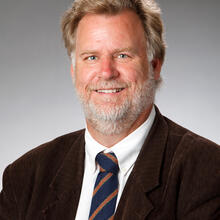The bronze serpent which Moses lifted up in the desert (Numbers 21:4-9) becomes a "type" of the Christ, who is to come, in the Gospel of John. While the bronze serpent held up by Moses heals the Israelites of the snake bite that leads to physical death, Jesus upon the cross heals us from the wounds which lead to an eternal and spiritual death. The bronze serpent is, in allegorical terms, a symbol of the eternal life which Jesus brings to all who believe in him through his suffering on the cross. It is a model, especially as it is Jesus himself who offers the interpretation of the Numbers passage, of the spiritual interpretation of scripture, which often resides alongside, but does not obliterate, the literal meaning of the text in question. Following after this interpretation, though, is a verse, John 3:16, which is one of the best known verses in the American biblical landscape. Many know it from sporting events, where a man in a rainbow wig often held up a sign, reading simply, "John 3:16." For those who have had contact with evangelical churches, you will know how powerful a role this verse plays in their soteriology. There is no question why this is the case: the verse is an encapsulation, a powerful brew, of the Gospel of John’s poetic cosmology behind which lies the eternal word of God, the Logos made flesh. The verse seems clear and it is. Through Christ God redeemed the world and through Him we can receive eternal life. But only verses prior to this Nicodemus had been left confused by Jesus’ claim that we must be "born again" (or "born anew"), asking if that meant he had to re-enter his Mother’s womb. As so often in the Fourth Gospel, listeners and interlocutors mistake the spiritual sense of Jesus’ words for the literal sense. Yet, it is often the case that the literal sense embodies a spiritual sense – "For God so loved the world that he gave his only Son so that everyone who believes in him might not perish but might have eternal life." It is hard to be more literal than this: real love, sacrificial and universal, in the pouring out of a Son’s true life for the sake of a life that will never end. And it is hard to miss the spiritual home-truths which were embodied in Jesus Christ: he became literal flesh so that we might have a spiritual life everlasting. John W. Martens
John 3:16
Show Comments (
)
Comments are automatically closed two weeks after an article's initial publication. See our comments policy for more.
The latest from america
At a Mass for the Jubilee of Youth outside Rome, Pope Leo exhorted over a million young people to be "seeds of hope" and a "sign that a different world is possible."
Perhaps it is the hard-won wisdom that comes with age, but the Catholic rituals and practices I once scorned are the same rituals and practices that now usher me into God's presence, time and time again.
"Only through patient and inclusive dialogue" can "a just and lasting conflict resolution can be achieved" in the long-running conflict between Israelis and Palestinians, said the Holy See's permanent observer to the United Nations.
The ”Bad Guys” films ask, how do we determine who the “bad guys” are? And if you’re marked as “bad” from the start, can you ever make good?







